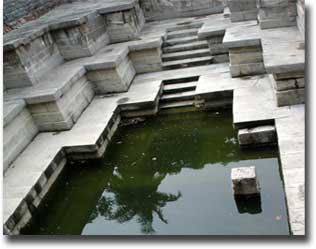Location
This temple is in shape of a star and has three shrines dedicated to Lord Shiva, Vishnu and Surya. The temple is built on a 1m high platform on the slopes of the Hanumakonda hill, and has a majestic monolithic Nandi. The black basalt Nandi, a monolith, has a lovely polished finish. There are many small lingam shrines surrounding the gardens. The temple is famous for its richly carved pillars, screens and detailed sculpture. The atmosphere is calm and serene with the sonorous ringing of the puja bells, gentle chirping of the birds and the soothing cool breeze.

Significance of the temple
A quite drive of about 3 hours from the capital of Andhra Pradesh, Hyderabad would take the devotees 157 Km away to the ancient city of Warangal. The erstwhile Kakatiya capital of the 11th and 12th century is known for its shimmering lakes, beautiful temples and magnificent wildlife. The Kakatiya's ruled the city for over 200 years, decorating its interiors with some of the very best architectural splendors.
The most famous of the structures is the thousand pillar temple, built in 1163 AD by king Rudra Dev. Built according to typical Chalukyan style of architecture, the thousand pillar temple is dedicated to Lord Shiva, Vishnu and Surya. One thousand ornately carved pillars adorn the temple complex while a huge granite statue of Nandi, the bull is placed at the entrance. Neatly carved rock elephants built on either side greet the visitors at the temple entrance.
There are many small lingam shrines surrounding the gardens. Popular for its richly carved pillars, screens and detailed sculpture, Thousand Pillar Temple is one of the most visited temple in India.
Time to visit

Other places to visit
Bhadra Kali Temple is situated on a hilltop between Hanamkonda and Warangal, it is noted for its stone image of the Goddess Kali.
Jain Temple which is 2,000-year-old Jain temple of Mahaveer is a famous place of worship for Jains in the country. The temple is embellished with beautiful images of Thirthankaras. The 5ft high image of Mahavira is entirely carved of Jade. Kolanupaka is 80-km from Hyderabad, and is situated between Hyderabad and Warangal. This was the second capital town of Kalyani Chalukyas during the 11th century AD. During this period the village was a religious centre of Jains, and ranks among other great Jain centers in the south.
Sri Veeranarayana Temple is raised in the Chalukyan style around 1104 AD.
Pakhal Lake is a man-made lake built in 1213 AD by the Kakatiya king, Ganapathidev, by harnessing a small tributary of the Krishna River. It is located 50-km from Warangal and spreads over an area of 30-sq-km.
 |
Nearby tourist places to Thousand Pillar Temple
Tirupathi Visakhapattinam Warangal |
Ramappa Temple or Ramalingeswara is the temple situated in Palampet village, which is 70-km form Warangal. This is a beautiful monument dating back to 1213 AD. It displays the glory and richness of the Kakatiya kingdom. |
Accommodation facilities at the Temple

How to reach the Temple
- Through Airways: Through Airways the city has domestic airport situated at Hyderabad which is the nearest and most convenient air connection with the rest of the country. Indian Airlines connects Hyderabad with Delhi and other major cities of India. For more information on flight schedule and timings refer to the official website of Indian Airlines.
- Through Railways: Through Railways the city of Warangal has its own railway station which connects it to major Indian cities. Important daily trains between Delhi and Warangal are the G T Exp., Tamil Nadu Exp., Kerala Exp. and Dakshin Exp. For train timings and online bookings, refer to the official site of Indian Railways
- Through Roadways: Through Roadways, the state of Andhra Pradesh has transport corporation operating regular buses for Warangal to all the major neighbouring cities including Hyderabad, Vijayawada, Karimnagar and Khammam. Private taxis can also be hired, available from various locations around the city.
- Through Local Transport:Through Local Transport the temple is accessible where the facilities are easily available and primary means of transport to move around inside the city include Buses, Taxis, auto-rickshaws and cycle rickshaws.



